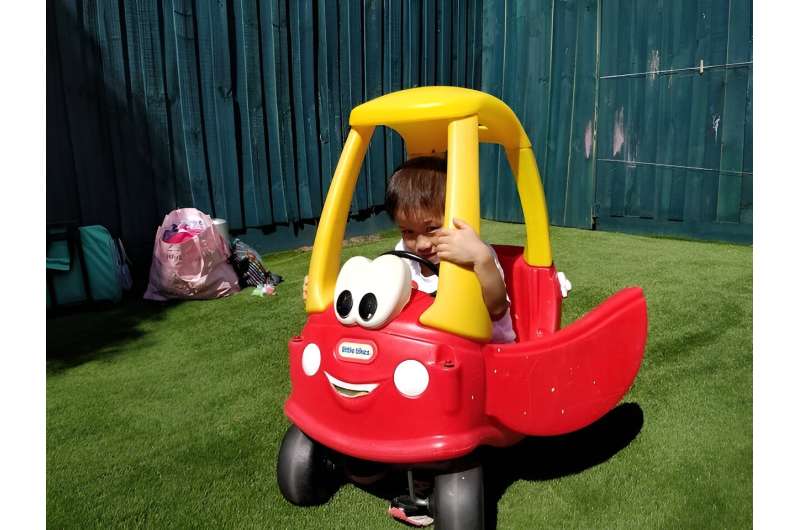This article has been reviewed according to Science X's editorial process and policies. Editors have highlighted the following attributes while ensuring the content's credibility:
fact-checked
trusted source
written by researcher(s)
proofread
Lego releases braille bricks—here's how five other brands could make their toys more accessible

Lego has announced that its braille bricks—already popular among services and schools serving visually impaired children—are now available for public purchase.
Improving accessibility in children's toys and games is an urgent and multifaceted issue. The diverse play access needs of children relate to a wide range of physical and sensory impairments, emotional and learning needs and neurodiversity. Good toy and game design should avoid attempts to "correct" children's play. It should focus instead on how toys and games can better meet the play interests—and access and representation needs—of a wide range of children.
Toys adapted for specific play needs are sometimes prohibitively expensive. The prevalence of parents, older children and engineering students already working together on modifications and hacks are testament to the appetite for accessible adaptations. A universal design (design that supports accessibility for all) approach, where accessibility is built in as standard, rather than added on, may offer useful inspiration.
Along with colleagues, my work at the University of Sheffield highlights how digital play design that supports equitable play for diverse children's bodies can support important well-being benefits. However, many popular toys and games, both digital and otherwise, are currently inaccessible to many children.
Toys with small parts or operating mechanisms, for example, are often inaccessible to children with visual or mobility impairments. Simple adaptations, however, could make them accessible to a much broader range of children. Meanwhile, echoing recent research on the children's media industry, a concerning range of digital games are still failing to build in progressive representations of disability and diverse bodies.
But evolving technologies could offer opportunities. For example, recent research from Lodz University of Technology trialed "interactive sonification" of images in games to help visually impaired children experience shapes and colors through sound. However, as Lego's braille bricks emphasize, equitable toy and game design need not be complicated.
So how could the teams behind other well known toys and games work with disabled children to improve accessibility? Here are a few suggestions.
1. Big buttons for My Pal Violet
Interactive animals such as LeapFrog's My Pal Violet bring comfort to many toddlers. However their adorable, squeeze-activated paws and ears are inaccessible to some children, including those with limited mobility and fine motor skills.
Fitting Violet with big buttons would improve accessibility. Better still would be adding a mono jack (a connector that transmits signals) to the circuitry of toys like Violet as standard. This would enable parents and caregivers to add their own "off the shelf" activation switches, such as pull strings, buttons or hand or foot pedals.
2. AI Barbie dolls
The box office success of the Barbie movie has catapulted the Barbie doll back into the public eye. But integrating artificial intelligence (AI) could help Barbie better support a range of social and emotional play needs. AI Barbie could interact verbally with children in increasingly sophisticated ways, offering opportunities for creative conversations.
Though Mattel's discontinued, internet-connected Hello Barbie raised privacy violation concerns in the ways it shared children's data, a range of recent studies have highlighted the social and emotional benefits of playing with AI toys such as robots. The technology shows potential to support children's well-being through inclusive design.
Playing with robots in early childhood has been shown to support empathetic play, emotional awareness and turn-taking for nonverbal children and children with a range of other diagnoses and learning and emotional needs, including ADHD.
3. Fully customizable Minecraft
Minecraft already offers impressive accessibility features such as an optional speech to text setting to enable children to communicate through voice in the game, using dictation tools. But there is still work to be done on design features supporting customization and their links to the representation of diverse children's bodies.
Recent work has emphasized the need to develop digital games that reflect all children, whether that is in relation to race, ethnicity, gender, class, sexuality, physical difference or disability. Fan-generated modifications and online petitions highlight the sustained appetite for fully functional wheelchairs within the Minecraft universe.
Hasbro's The Sims is a good example of bodily representation in digital games, offering advanced customization, including medical wearables such as hearing aids, as well as elements to reflect diverse body shapes and sizes, although feeding tubes, wheelchairs and wheelchair-accessible surroundings are still not available.
4. Motorizing the Cozy Coupe
Little Tikes' Cozy Coupe is a longstanding early childhood staple, but optional motorization features could make the Coupe an accessible toy for more families.

A range of research has demonstrated how modification of ride-on toy cars through motorization and the addition of large, more easily operable controls can support independent mobility and social benefits for mobility impaired children, including those with cerebral palsy.
5. Visually emphasizing danger in Crossy Road
Though digital games offer important benefits to a diverse range of children, there are still obstacles to equitable play for the industry to work on. One example is the inaccessibility of games which rely on sound as a game mechanic for deaf children and children with hearing loss.
Research has emphasized the need to offer alternative mechanisms to navigate these titles, such as visual reinforcement. A game like Crossy Road warns children of the danger of ongoing vehicles through both visual and auditory cues (for example, an increasing volume in traffic noise). Children with limited hearing are therefore at a disadvantage that could be addressed by something as simple as optional fluctuating light or color cues.
Though the task is by no means straightforward, the digital games industry must continue to consider minimum accessibility standards that can be implemented across the industry to better meet the diverse digital play needs of a broad range of children.
Provided by The Conversation
This article is republished from The Conversation under a Creative Commons license. Read the original article.![]()




















